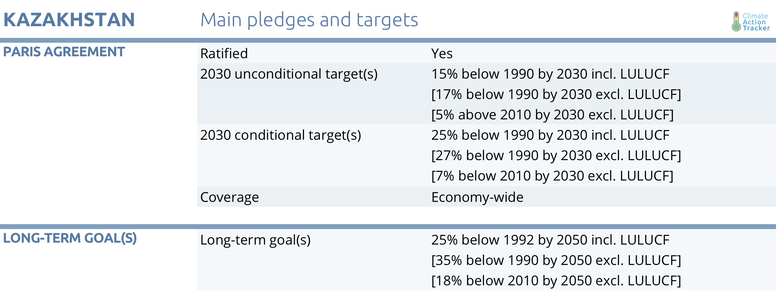Country summary
Overview
With oil production having reached a record level in 2018 and further plans to expand coal and oil production, Kazakhstan is deepening its dependence on fossil fuels and failing to take steps towards achieving a Paris Agreement-compatible emissions pathway.
The renewable energy targets of 3% by 2020, 10% by 2030 and 50% by 2050 need to be considerably strengthened to match Kazakhstan’s stated recognition of the need to transition into a greener future. Prioritising the modernisation of existing coal plants, as well as planning to replace some coal capacity with natural gas is short-sighted, considering that gas is not a long-term solution for the deep decarbonisation needed to keep warming to 1.5˚C. Current policy projections remain “Highly Insufficient” and are projected to miss Kazakhstan’s “Insufficient” Paris Agreement target by a wide margin.
On a more positive note, the Kazakhstan ETS resumed operation in 2018 after a one-year hiatus and, following two successful renewable energy auctions in 2018, the third auction in September 2019 was awarded to a 48MW wind power plant project that should be ready in 2022.


Kazakhstan’s currently implemented policies would lead to a 3% reduction in emissions from 1990 levels by 2020 (376 MtCO2e - excluding LULUCF) and a 9% increase above 1990 levels by 2030 (419 MtCO2e - excluding LULUCF). Currently implemented policies are far from sufficient to meet its targets—if the CAT were to rate Kazakhstan’s projected emissions levels under current policies for 2030, Kazakhstan would be rated “Highly insufficient”.
Kazakhstan’s Nationally Determined Contribution (NDC) contains an unconditional target to reduce GHG emissions by 15% below 1990 levels by 2030, including emissions from land use, land use change and forestry (LULUCF). If emissions from the LULUCF sector are excluded, this target is equivalent to an emissions reduction of 17% below 1990. Based on this unconditional NDC target, we rate Kazakhstan “Insufficient.” The “Insufficient” rating indicates that Kazakhstan’s climate plans are not consistent with holding warming to below 2°C, let alone limiting it to 1.5°C as required under the Paris Agreement, and is instead consistent with warming between 2°C and 3°C.
Kazakhstan also has a conditional target of reducing emissions (including LULUCF) by 25% below 1990 levels by 2030 (equivalent to 27% below 1990 levels excluding LULUCF by 2030). This target is subject to “additional international investments, access to low carbon technologies transfer mechanism, green climate funds and flexible mechanism for country with economy in transition”.
Further analysis
Latest publications
Stay informed
Subscribe to our newsletter




